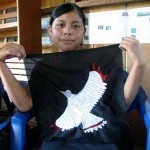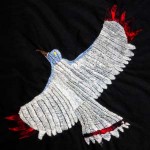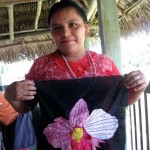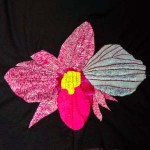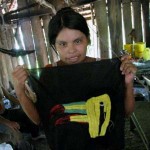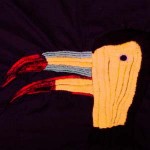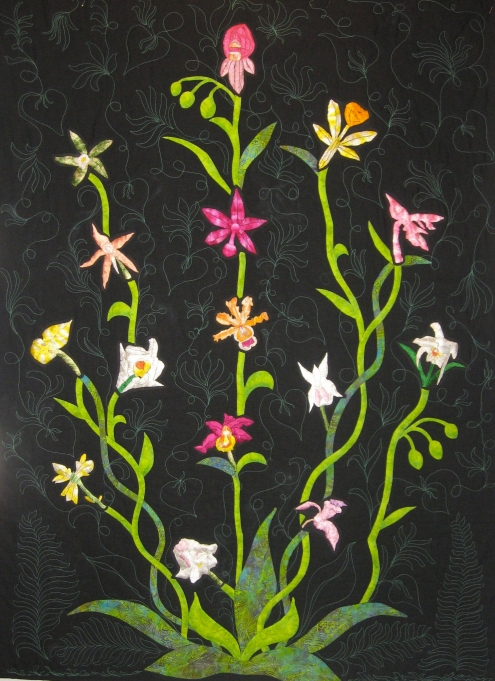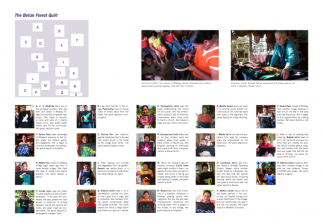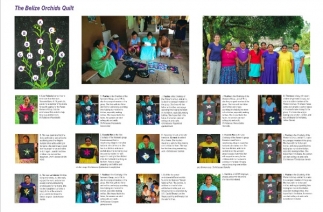Preserving the Rainforest Quilts
Background
Background
|
Between 2011 and 2012, Peace Fellows The park is threatened by an oil company, US Capital Energy. The company has already carried our tests, much to the alarm of SATIIM (The Sarstoon Temash Institute for Indigenous Management). SATIIM, an AP partner since 2011, manages the park under a special agreement and insists that it is protected from any development. This is disputed by the government. Villagers have not taken a clear position, but in producing their tiles the two quilting groups have certainly made a strong statement for preserving the forest. The Belize Forest Quilt (2011)
Amy Bracken was the first Fellow to be deployed to SATIIM and she was not initially enthusiastic about quilts. As she wrote in a blog: “Quilting is not something I ever associated with human rights campaigning. It seemed so American. True, the AP quilts I saw were interesting and beautiful, but this thing was not for me, I was sure, and not for a campaign against oil drilling in a national park in Belize.” Then, some way into her fellowship, Amy changed her mind: “I was getting ready for work one morning… It was market day, and Mayan men and women were coming into town from the villages to sell produce and handicrafts. One woman knocked on my door, and in spite of my quiet protests, marched into my living room and began to display her various crafts. Among them were squares of cloth on which she had embroidered Mayan calendars and gods. She had grown up doing this. It was part of her culture. Essentially, these things were quilt tiles. I thought about (AP’s) idea of having colorful animals and plants popping out from black cloth. “I bought a panel embroidered with the Mayan god of corn/fertility, and brought it into work. When my Q’eqchi co-worker Cordelia, the SATIIM park manager, saw it, her eyes widened. She said most village women know how to embroider. She had grown up doing it herself, and the next day she brought in samples of flowers she was sewing with bright shiny thread. Suddenly, this quilt idea seemed perfect.” 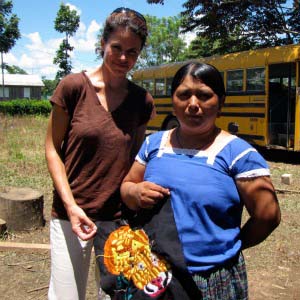 Peace Fellow Amy Bracken oversaw the making of the Forest Quilt in 2011. Amy is seen here with Seferina Ishim, Secretary of the Midway quilting group. But, as Amy learned, things move slowly in Belize. Cordelia and Amy decided to try the idea on the village of Midway, with a population of 350. Amy wrote letters to the mayor and Cordelia called a meeting. The women trickled in. Amy and Cordelia then explained the idea, working with photos of earlier quilts. No-one moved. Amy described what happened next in a hilarious blog – “Quilting – a Thriller.” “We asked who might be interested in the project. Nothing. I was really starting to sweat now.” Four people signed on, and Amy resigned herself to failure. Then, after the meeting was adjourned, nine more women came forward – including several who had not sewn before. Before she knew it, Amy had a team of fourteen. They then held elections. “We scheduled another meeting for embroidery training and quilt planning. No one replied when I said goodbye that afternoon, but I left with a nervous sense of excitement that this thing quilt thing just might actually work out.”  Brigida Ishim attracts a crowd in the Midway quilting group as she embroiders an orchid for the Forest Quilt. Needless to say, the process became much easier. Amy went to the next meeting with Acela, an administrative assistant at SATIIM, and Acela’s two teenage brothers, who both knew how to draw. After two hours women were clustered in groups, “watching each other sew and laughing, really laughing. If nothing else, we had created a reason for village women to come together and have a good time. No one replied when I said, ‘Bye! See you next week!’ but I knew they’d be there.” Amy produced wonderful little vignettes and photos of the artists, whose love of the park shines through in their designs.Seferina Ishim, the group secretary, embroidered a jaguar. Her husband Tomas, is a SATIIM park ranger. She sees a lot of deforestation outside the park, and believes drilling would contaminate water and spread sickness. Paulina Pau, the group treasurer, lives in a house made of emergy wood from the forest and uses medicine from plants which are found in the forest by the village bush doctor. Paulina embroidered a green snake. For much of the project, Amy described her role as a “mule – driving to the village, finding out who needed more of which color thread, and going back to the stores in Punta Gorda, where the poor young salesmen had to search, repeatedly, through sometimes dozens of boxes to find a match to my sample. Then back to Midway for a delivery. But as a mule I felt I was doing good. The women got really into the project, and were proud of their products, with good reason. Many had never embroidered before, and they were producing beautiful, vibrant images.”  Distributing quilting supplies at the Santa Teresa group. Amy also concluded that the project was empowering to the women, who spent most of their lives doing household chores. “They were happy to have something else, something different to add to their list of tasks each day. For some it was quiet time in the hammock, away from the family. Others liked teaching the craft to village children.” Amy returned to the US and posted the tiles to AP. We were amazed at the artistry. The silk backing was gossamer thin, but the embroidery was divine. We then looked for a quilter who could do them justice, and located Barbara Barber in Rhode Island. Left to her own devices and working from a veteran swing machine, Barbara used a large tree to symbolize the unity of the forest ecosystem, and attached the individual tiles. Her resulting quilt is one of the most original in the AP collection. The Belize Forest Quilt was first displayed at the UN on March 8, 2012, and then again in 2013 at Kean University. The challenge now is to generate some money for the Midway artists, whose needs are many. Amy Bracken raised $600 at a fair in Boston, but AP has not, as yet, made money from the quilts. We hope this will change in 2014, as the greeting cards are sold. The Belize Orchid Quilt (2012)
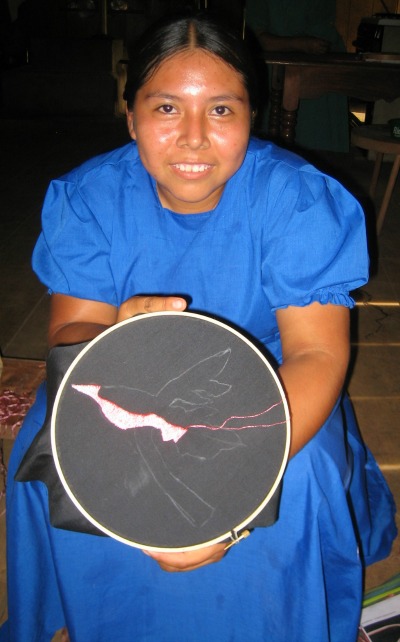 Paulina Max was the secretary and also the youngest member of the Santa Teresa group. She produced 4 embroidered squares for the Orchid Quilt. Laura Burns, who followed Amy to SATIIM as a Peace Fellow in 2012, was determined to return with tiles for a quilt. On the advice of Cordelia, from SATIIM, she chose a group of artisans that had formed recently in another village, Santa Teresa. At AP’s suggestion, she decided to propose a quilt devoted entirely to orchids found in the park – many of them rare. Like Amy the previous year, Laura had no idea how she would be received and her first fears appeared to be confirmed when she met with the Santa Teresa group, surrounded by “small children, village elders, and sisters and brothers of group members.” The six were well known in the area and described as “geniuses.” Laura took out her computer and showed photos of other quilts. The questions came slowly. During the long pauses, all Laura could hear were crickets in the jungle. Then, the ice began to break. Laura and a SATIIM Intern, Mari, had prepared boxes of thread and a kit for each square with a picture of an orchid, embroidery thread, and needles. “As I placed the kits on the ground, the women pounced! Any ounce of hesitation was gone as soon as the kits came out: women were grabbing enthusiastically, a hum of excitement filling the wooden room. Little girls soon entered the mix, grabbing the kits and admiring them first before delivering them to certain women, who at this point were now trading and bartering for different orchids. A smile of relief filled my face. The quilt wouldn’t be a failure after all!” The group elected Paulina Pau as their leader. Although only 19, Paulina is wonderful seamstress and made no fewer than three tiles. Cordelia and Acela from SATIIM organized training sessions, and they were off and running. As can be seen from Laura’s spectacular photos, the process was entirely collaborative: “All the women had different embroidery techniques, and it was fun to watch them excitedly share tips.” Their tiles were masterful – in design and needlework.  Peace Fellow Lauran Burns (left) shows Carmen Max the bio she has written on Carmen for the AP website. By the time Laura returned to Santa Teresa to collect the tiles, she was fast friends with the group. “These six women are amazing.” She was impressed with Paulina, the 19 year old dynamo and master craftswoman but particularly fond of Juanita, the only one of the group who had no prior experience of embroidering. “(Juanita) came off as a little aloof, and definitely not too pleased to be doing embroidery. I instantly pegged her as a kindred spirit…I would be feeling the same…. And that peg was right on, I later learned that Juanita managed to sew her hand multiple times during this project, something I totally would have done.” The quilting project proved to be the high spot of Laura’s summer. She had given them a chance to tell their story, but gained much in return: “I hope that by giving them a forum to demonstrate their talents, I’ve expanded these women’s lives, even if it is in the smallest of ways. I know I’ve learned a lot from these women, expanding my catalog of experiences. And my heart, well, it just continues to grow.” 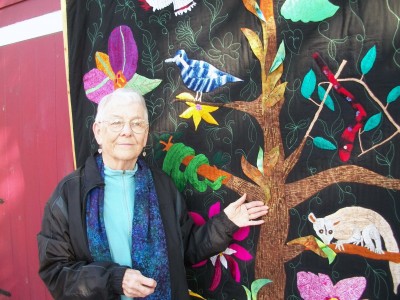 Barbara Barber, a well-known quilter from Rhode Island assembled the two Belize quilts on a small sewing machine at her home. As in 2011, AP again turned to Barbara Barber in Rhode Island to assemble the tiles and once again, Barbara quilted a tree to hold the orchids against a black background. The orchids themselves are deep and rich against the black background. The quilt was exhibited at Kean University alongside its sister quilt from Belize, for most of 2013. It then went on display at the Textile Museum in Washington in November. AP is producing one set of ten greeting cards from the two Belize quilts, and will send all proceeds to the two village groups. Laura’s quilt produced one unexpected and heart-warming outcome. After her graduation, Laura went on to work on microcredit in Colombia. Before she left she was contacted by a charity in Minnesota that works with women in prison. They wanted to make quilts for poor children. Laura contacted the Santa Teresa group through SATIIM, and asked if they would produce tiles. They did – free of charge – and the quilts were assembled inside an American jail. |
Belize Forest
Belize Forest
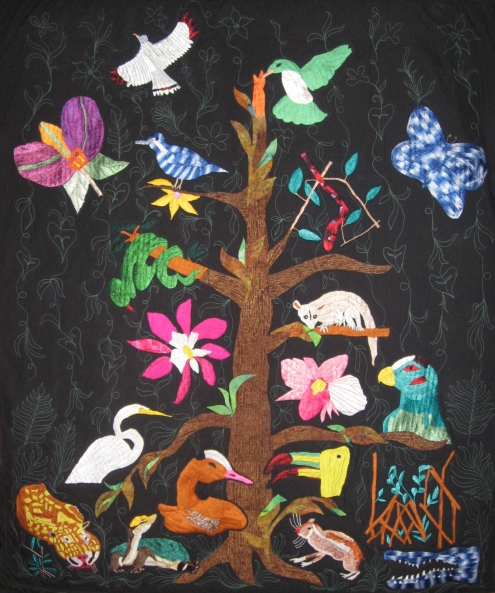 |
|
Concepciona Ishim Concepciona Ishim stays busy taking care of her four children while her husband works three weeks a month in Belize City. Still, she enjoyed learning to embroider and hopes to be involved with more such projects. For this panel, Concepciona embroidered a black orchid, one of the many native flower species in the Sarstoon Temash National Park. Concepciona says she loved sewing her quilt panel. She had embroidered panels to sell to American missionaries when they came to build a church. She hopes to make and sell more in the future. Concepciona chose to embroider an orchid, one of the many native flower species of Belize. |
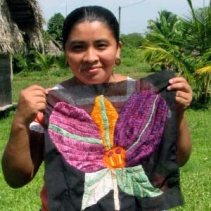 |
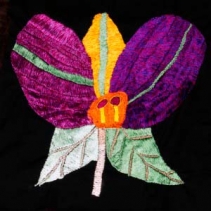 |
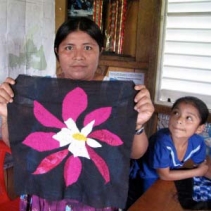 |
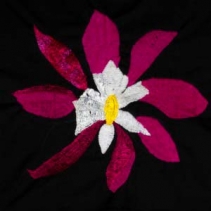 |
| Seferina Ishim
Seferina Ishim (right, with Peace Fellow Amy Bracken) moved to Midway from another village to be with her now husband, Tomas, a SATIIM park ranger. She sees a lot of deforestation outside the park, so she’s glad that a large area is protected. She believes drilling would contaminate water and spread sickness. Seferina is the secretary for the wuilting group, and she embroidered a jaguar for this panel. She also chose to embroider a gibnut, an important food source for the people living near the park. |
 |
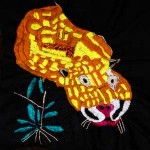 |
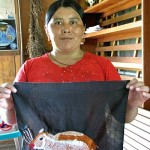 |
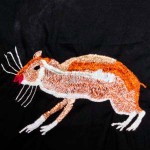 |
| Rosaria Ico
After cooking corn tortillas and vegetables from her garden, Rosaria Ico relaxes in a hammock to embroider. She has fond memories of a peaceful childhood here, playing soccer with neighbors, but she’s seen improvements: electricity, and drinking water from a spigot in the middle of the village. Rosaria’s panel features a white egret and the mangrove. |
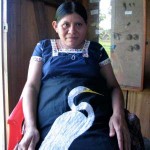 |
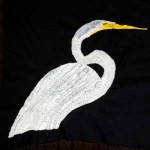 |
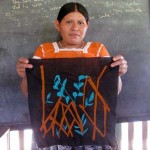 |
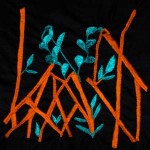 |
| Ercilia Ishim
While her husband attended university, Ercilia Ishim spent eight months in town – an experience she does not want to repeat. She found it boring and missed taking walks in the forest and bathing in creeks. “It is very beautiful to see and well-protected.” If the park isn’t protected, she says, people will lose access to medicine, and if drilling happens, places will become off-limits, and water might be contaminated. Ercilia embroidered a panel of the Hicatee turtle, a native species to Belize which is currently endangered, as well as a duck. |
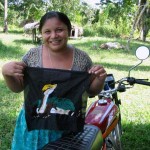 |
 |
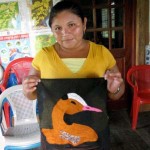 |
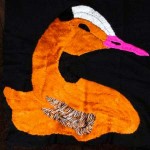 |
| Routhilia Ico
At 18, Routhilia Ico is one of the youngest quilters. She was born and raised in Midway but just completed high school near town. She hopes to become a nurse and work at the closest staffed health clinic, in a neighboring village. She wants expanded health care in her community. For her panel, Routhilia embroidered a white dove. |
| Martha Canelo
Martha Canelo does not know if oil drilling would benefit her community or not. She has heard both sides. One thing she would like to see in her community is health services. US Capital Energy built a small health post in the village, but she says five months later it still hasn’t opened. In this panel, Martha embroidered the Indigo Bunting, a native bird to the National Park. Martha also embroidered the Morelet’s Crocodile, an animal that is only found in the fresh waters of Belize, Mexico and Guatemala. |
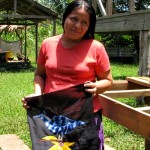 |
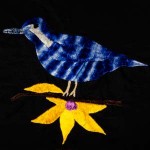 |
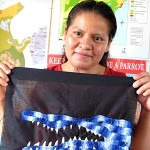 |
 |
| Paulina Pau
Like most people in the village, Paulina Pau lives in a house made of emergy wood from the forest. She also gets headache medicine derived from plants, which are found in the forest by the village bush doctor. Paulina is the treasurer for the quilting group, and for this panel she embroidered a green snake and a hummingbird. |
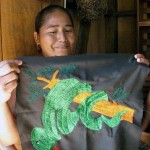 |
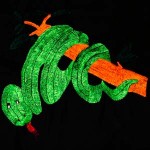 |
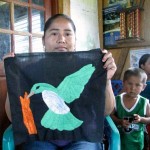 |
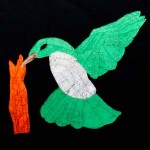 |
| Verona Paau
Verona Paau says moved to Midway from another village because it was one of the few in the area that had electricity. She also benefits from the proximity to the forest, where she goes for greens. She is eager to find out what other opportunities there might be to create textiles. Verona is the vice-chairlady for the quilting group. For her panels, Verona depicted a red snake and a blue butterfly. |
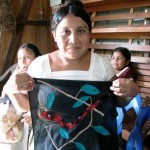 |
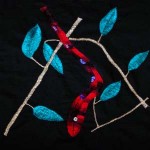 |
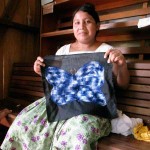 |
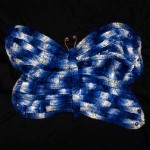 |
| Martha Pau
Martha Pau’s four-year-old son, Darwin Che, keeps her company when she embroiders. She moved here eight years ago from a more remote village. She likes the idea of doing more textile projects. Her panels feature an opossum and a parrot. |
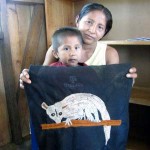 |
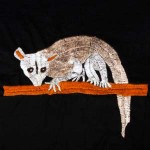 |
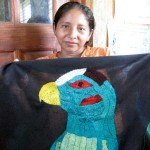 |
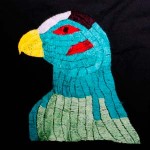 |
| Brigida Ishim
After a day of cooking and cleaning, Brigida Ishim loves to sit in her hammock and sew, ideally making products for sale. “We are poor in this village.” The forest is an important resource for her and her family. It is where they get gibnut meat, fish, and calalou. She worries about oil drilling for its health effects, and hopes SATIIM’s work can stop it. Ms. Ishim in the Chairlady of the quilting group. She embroidered a pink orchid for this panel. |
| Candelaria Chub
Candelaria Chub was born and raised in Midway. Speaking Q’eqchi Mayan through an interpreting fellow quilter, she said she spends her days doing chores, including farming, which she loves, and she hopes to continue to sew. For the quilt, she embroidered a toucan. |
Belize Orchids
Belize Orchids
|
|
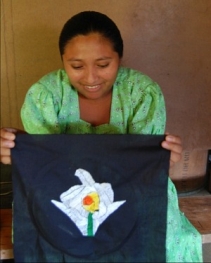 |
Carmen Max
Speaking through a Q’eqchi’ translator, Carmen described life at home. She has two daughters, and she likes making corn tortillas for them. This was her first time doing embroidery work. The panel depicts an Orchidaceae Sobralia. |
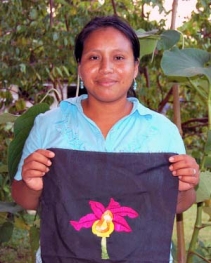 |
Cordelia Requena
Cordelia, a SATIIM employer, proudly poses with the orchid she has embroidered. |
 |
Juanita Ishim
This was Juanita’s first time doing embroidery, and while she accidentely poked her fingers multiple times while working on her panel, she said it was a good learning experience and wants to do it again. Juanita has three children: one son and two daughters. The panel depicts an Orchidaceae Vanilla Hartii. |
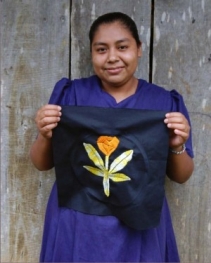 |
Lorrainia Choco
This was Lorrainia’s first time doing embroidery, but she really enjoyed the work, and she has already started embroidering another panel for her home. She has two daughters. Lorrainia is happy to be in the women’s group, and looks forward to similar projects. The panel depicts an Orchidaceae Vanilla. |
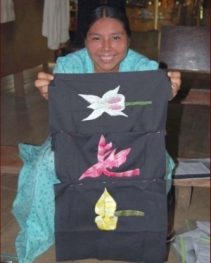 |
Paulina Max
Paulina is the Chairlady of the Women’s Group, and at 19, is also the youngest member of the group. She lives with her father and mother, and enjoys spending time helping her mom in the kitchen, especially making tortillas. Paulina is excited about the women’s group, and together with the women, is selling baked goods and tamales to raise money for the group. She hopes that in the future, the women can start selling arts and crafts. The panels depict from Top to Bottom: Orchidaceae Oeceoclades maculate (Monk Orchid), Orchidaceae Gongora quinquenervis (Gongora Orchid), Orchidaceae Trigonidium egertonianum (Egerton’s Trigonidium), Orchidaceae Polystachya clavata (The Leafy Polystachya), Orchidaceae Macradenia brassavolae (The Brassavola-Like Macradenia), Orchidaceae Sobralia (Sobralia Orchid) |
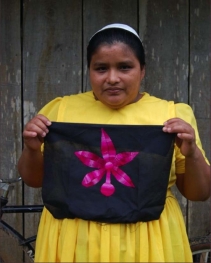 |
Rosaria Max
Rosaria Max is the Vice Chairlady of the Women’s group. Rosaria moved from a neighboring village to marry her husband, who farms corn. She has four children, and she is excited about the women’s group because it provides her with support in caring for her children while her husband is working on the farm. Rosaria enjoys preparing corn tortillas and chicken soup. The panels depict an Orchidaceae Epidendrum Imatophyllum. |
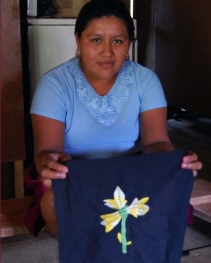 |
Thomasa Muku
Thomasa is busy with seven children (4 girls and 3 boys), but she is an active member of the Women’s Group. Thomasa makes cakes and tamales to sell on buses in the area to raise money for the group. Thomasa also enjoys making stew chicken, tortillas, and rice and beans for her family. The panel depicts a Yellow Clavata. |


